A new world-record for fusion energy output has been set by a UK-based experimental reactor in its final trials.
The Joint European Torus (JET)—which is based at the Culham Centre for Fusion Energy in Oxfordshire—is one of the world's largest and most powerful fusion machines.
The same phenomenon that powers the hearts of stars like the Sun, nuclear fusion involves smashing light atoms together to make heavier ones at temperatures of a whopping 180 million Fahrenheit.
This process releases a staggering amount of energy, many times more than achieved by fission", the splitting of atoms, as used in current nuclear power plants.

JET belongs to a type of fusion reactor known as a "tokamak", a doughnut-shaped device in which the hydrogen fuel is transformed under intense pressures and temperatures into plasma—a hot, electrically-charged cloud—and contained by powerful magnets.
(The other type, dubbed "inertial confinement fusion", involves using lasers to compress and heat static targets filled with hydrogen fuel.)
JET completed its final experiments in December last year. Before doing so, however, it demonstrated the ability to reliably generate energy from nuclear fusion.
By smashing together atoms of deuterium and tritium—both types of hydrogen—the reactor succeeded in producing high levels of power for five seconds, releasing a record-breaking 69 megajoules of energy with just 0.2 milligrams of fuel.
"By my estimate this is enough energy to make over 600 cups of tea," professor Stuart Mangles—a physicist from Imperial College London, England—said in a statement.
The previous world-record stood at 59 megajoules, achieved by JET back in 2022.
"Recreating the conditions in the center of the Sun on Earth is a huge challenge," nuclear engineer Aneeqa Khan of the University of Manchester, England, told Newsweek.
"These results are really exciting for the fusion community and a great end to the operations of JET—which has provided the scientific community with really valuable data over its lifetime, feeding into the designs for new projects."
However, Khan noted, commercial fusion power plants still remain "a way off"—and are likely not going to be viable until the second half of this century.
Despite JET's record-breaking output, she explained, the reactor still did not produce more energy than was put into it.
"Building a fusion power plant also has many engineering and materials challenges. However, investment in fusion is growing and we are making real progress," she said.
"We need to be training up a huge number of people with the skills to work in the field and I hope the technology will be used in the latter half of the century. Global collaboration is key in achieving this."

Andrew Bowie is the UK Minister for Nuclear and Networks. In a statement, he said: "JET's final fusion experiment is a fitting swansong, after all the groundbreaking work that has gone into the project since 1983.
"We are closer to fusion energy than ever before thanks to the international team of scientists and engineers in Oxfordshire."
Professor Sir Ian Chapman—the CEO of the UK Atomic Energy Authority—agreed, saying in a statement: "JET has operated as close to powerplant conditions as is possible with today's facilities."
"JET's legacy", he added, "will be pervasive in all future powerplants. It has a critical role in bringing us close to a safe and sustainable future."

"Our successful demonstration of operational scenarios for future fusion machines like ITER and DEMO, validated by the new energy record, instill greater confidence in the development of fusion energy," said plasma physicist professor Ambrogio Fasoli, who chairs EUROfusion, the umbrella organization for the development of fusion power in Europe, in a statement.
He added: "Beyond setting a new record, we achieved things we've never done before and deepened our understanding of fusion physics."
Fellow plasma physicist Emmanuel Joffrin is EUROFusions Tokamak Exploitation Task Force Leader. In a statement, he explained how JET has helped paved the way towards future experimental and commercial fusion reactors.
"Not only did we demonstrate how to soften the intense heat flowing from the plasma to the exhaust, we also showed in JET how we can get the plasma edge into a stable state thus preventing bursts of energy reaching the wall.
"Both techniques are intended to protect the integrity of the walls of future machines. This is the first time that we've ever been able to test those scenarios in a deuterium-tritium environment."
Nuclear fusion is considered to be a green source of energy, as it does not result in the release of the greenhouse gas carbon dioxide into the atmosphere.
However, Khan cautions, we cannot rely upon it as a solution for the present climate crisis.
"We are already facing devastation from climate change on a global scale," she said.
"In the short term we need to use existing low carbon technologies such as fission and renewables, while investing in fusion for the long term, to be part of a diverse low carbon energy mix."
She concluded: "We need to be throwing everything we have at the climate crisis. It is important to have both short and long term strategies."
Do you have a tip on a science story that Newsweek should be covering? Do you have a question about nuclear fusion? Let us know via science@newsweek.com.
Update 08/02/24, 8:16 a.m. ET: This article was updated to include the previous world-record fusion energy output.
Update 08/02/24, 8:51 a.m. ET: This article was updated to include comment from professor Stuart Mangles.
Uncommon Knowledge
Newsweek is committed to challenging conventional wisdom and finding connections in the search for common ground.
Newsweek is committed to challenging conventional wisdom and finding connections in the search for common ground.
About the writer
Ian Randall is Newsweek's Deputy Science Editor, based in Royston, U.K. His focus is reporting on science and health. He ... Read more
To read how Newsweek uses AI as a newsroom tool, Click here.








